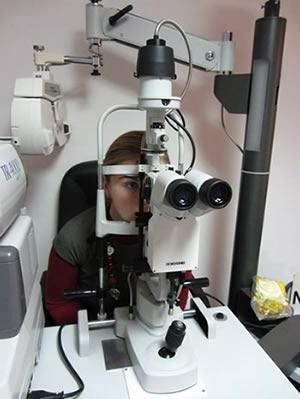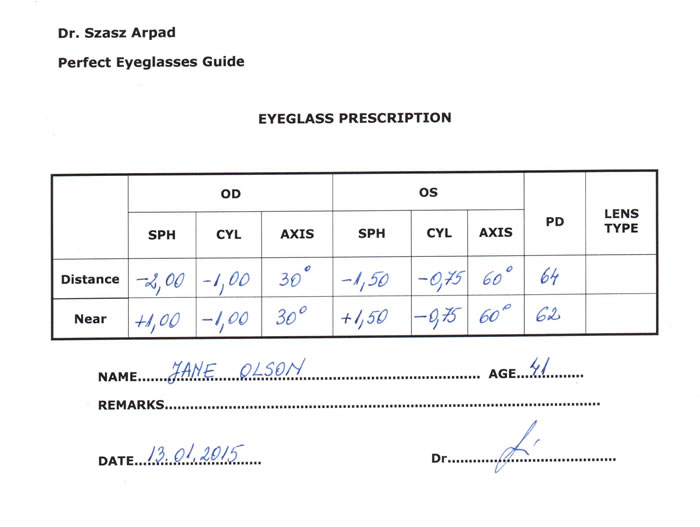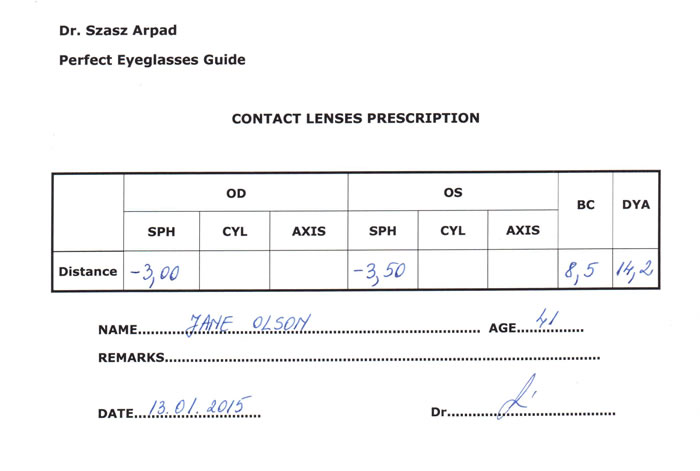How to Read Eyeglass Prescription for Bifocals
Eyeglass Prescription Explained

You need an eyeglass prescription, if you want to brand your first pair of glasses or you lot merely change the old ones.
You already know that the beginning step is to visit an optometrist or the ophthalmologist.
The prescription is usually a piece of paper or plastic that contains your personal information needed to make a pair of eyeglasses.
Only how many of you really know what is all that info written on the prescription? Or what is necessary to write there, so the optician can make a pair of efficient spectacles using that data?
I will endeavor to explicate you what and why is written there.
Types of prescriptions
There are many types of prescriptions. I volition bear witness you an example to encounter how information technology should look for your data:

On the higher up prescription, y'all tin can run into two types of data:
Mandatory data
Here we take: personal data, the diopters,interpupillary distance.
Personal data
This is your ID: proper name, historic period, gender everything that identifies y'all and is relevant for the optometrist.
The Diopter
This data is the most important part of the prescription. It represents your problem and its magnitude.
The diopter is a unit of measurement of the optical ability of the center, represented by numbers that shows the power of the lenses that compensate that problem.
As well regarding the diopter, on the prescription above we run across the following terms:
- OD and Bone - These are Latin words. They tell you which middle the prescription is for. "OD"(oculus dexter) is the right eye, "OS" (oculus sinister) is the left eye. Some prescriptions but use RE (correct eye) and LE(left eye)
- Distance - The diopters prescribed to help you see distant objects clearly
- Near - The diopters prescribed for a clear about vision
- Add together - On some prescriptions, you volition see the term "Add" instead of "Most". This number is used for bifocals and progressives, and information technology represents the added diopters to the altitude prescription to get the near vision prescription.
- SPH - Indicates the value of lens power, prescribed to correct the "spherical mistake". A (+) means the prescription is farsighted, and a (-) means the prescription is nearsighted. The higher the number after (+) or (-), the stronger the prescription.
- CYL - indicates the severity of the astigmatism.
- Axis - tells you which way the astigmatism is oriented.
- Prism - Sometimes you lot'll see this term on your prescriptions. It means the prism diopters needed to treat an eye disorder chosen phoria. Prism lenses have a thicker, and a thinner function called the base of operations and the top.
Yous have here some examples for various centre diseases, of how it should wait the diopter on the prescription:
Myopia:
Hypermetropia:
Astigmatism:
| SPH | CYL | AXIS | |
| -1.l | -1.00 | 150 |
On the above examples the numbers are just examples, only the signs of the numbers are how information technology should be in these different situations:(-) for myopia and (+) for hypermetropia.
Likewise, yous tin can see that the cylinder and centrality part is completed only in the instance of astigmatism.
If you suffer from astigmatism, this is a more particular recipe because it has two diopters and an axis. Information technology shows the magnitude of the vision trouble and the correction possibilities.
You volition run into that this kind of prescription can exist written in two ways, simply the 2 means the same matter. Information technology is of import to know, because some optometrists similar to write the prescription one way, others the other way and even they look different; they are the same.
There is a mathematical formula to calculate the diopters both ways. I will give you one example to see the difference, just y'all can enquire your optometrist to write it down for you both ways:
- With (+) cylinder: -2.50 sph +3.00 cyl 5 axis
- With (-) cylinder: +0.50 sph -three.00 cyl 95 centrality
These ii means are in fact the aforementioned thing. If y'all exercise take ii prescriptions from two optometrists, y'all will retrieve the diopters accept changed, but, in fact is the same thing simply written differently.
Interpupillary distance
This measurement determine the size of the frame. A small interpupillary distance asks for a smaller frame. It more often than not represents the distance betwixt the two pupils, more verbal the middle of the pupils written in millimeters.
I say by and large, because, in our shop, I utilize a different arrangement which I think is more exact.
I mensurate the distance between the nose span and the center of the pupil separately for left and correct eye.
I practise this because if a patient has a problem with simply i center (strabismus) or a deviated nasal septum, the master measurement is not exact. The same, I feel that is important to measure the distance separately when making progressive glasses because any small deviations volition affect vision and adaptation.
Optional data
Usually, this represents your personal options for the eyeglasses and is not always written on the prescription as:
- The material of the lenses
- Coatings (hardening, anti-reflective)
- Loftier index (for bigger diopters).
These options are not written but by the optometrist/ophthalmologist. They can be written by the optician besides. This kind of data is usually used when you brand your glasses in the same place yous brand the eye bank check, then they know your personal options.
The contact lenses prescription

A different kind of prescription is the one for contact lenses. Commonly, information technology looks the aforementioned with a small deviation. The mandatory office contains two more than data types:
- BC - the curvature
- DIA - the bore of the contact lenses.
If you lot have small diopters, like 1, 2 or three, you should know that the lenses diopters are the same with the contact lens diopters. In the example of bigger diopters, there is a conversion table for matching the air lens with the contact lens diopters.
For example: if you lot take (-4.75 sph) on air lenses, you lot will take (-4.25 sph) on contact lenses.
This divergence is because of the altitude of the lens from the eyes and the material and characteristics of the contact lenses
Questions and answers well-nigh eyeglass prescription
Over time we have received many questions most the eyeglass prescriptions.
Here are a few:
Only got my new glasses...
Centre strain
Cylindrical lenses
Astigmatism prescription
Difficulty adapting to eyeglasses
I've been wearing bifocals for near iii years now...
Eyeglass prescription fluctuation
Your eyeglass prescription
Every time you go to run into an middle doc, you must receive a copy of the recipe prescribed. Keep it and utilize it at any store you order optical glasses. I hope the above information volition assist you understand everything is written on your eyeglass prescription.
- Home ›
- Eyeglass Prescription
Was this information useful?
ane. Like Perfect-Eyeglasses-Guide.com on Facebook.
2. Share this article with your friends:
Source: https://www.perfect-eyeglasses-guide.com/eyeglass-prescription.html
Post a Comment for "How to Read Eyeglass Prescription for Bifocals"